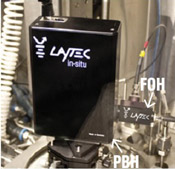- News
18 February 2016
LayTec's Gen3 in-situ metrology tool offers new features for UV LED epitaxy
After unveiling its third generation of in-situ metrology tools last October, in-situ metrology system maker LayTec AG of Berlin, Germany says that the EpiTT Gen3 is now available as the first representative of this Gen3 product class.
The backbone of the metrology's hardware and software is modularity. LayTec says that the new concept offers a wider range of process-specific customizations without compromising the robustness and accuracy of performance. Furthermore, the 24/7 operation is improved by separating data acquisition (based on ARM processors) from metrology control and analysis (based on MS Windows PC).
In addition, Gen3 offers a significantly extended choice of process interfaces, e.g. SECS/GEM for communication with MES systems and Modbus for Riber's latest Crystal XE software for MBE. Also, the real-time and post-growth data analysis functionality has been further improved. Several completely new hardware components can now be combined with proven work-horse modules that have also been integrated into the new Gen3 platform.
A particular application is the epitaxial growth of ultraviolet (UV) light-emitting diodes, which presents significant challenges, including long runs, superlattices, high aluminium content versus a high doping level, very high growth temperature, and large wafer bow, says LayTec. The firm says that Gen3 families of EpiTT and EpiCurveTT tools offer technology advances to solve most of these problems, citing the following example applications.
Overcoming the wafer-showerhead gap variation in UV LED epitaxy
 For UV LED processes, EpiTT Gen3 can measure temperatures up to 1500°C. However, a further key new Gen3 feature is the possibility to choose between two types of metrology head (see Figure 1): fiber-optical heads (FOHs) and the new parallel-beam heads (PBHs).According to LayTec, EpiTT with parallel-beam heads is the tool of choice, e.g. for Close Coupled Showerhead (CCS) reactors, where the wafer-showerhead gap is adjusted to avoid pre-reactions and to achieve high growth rates in UV LED processes.
For UV LED processes, EpiTT Gen3 can measure temperatures up to 1500°C. However, a further key new Gen3 feature is the possibility to choose between two types of metrology head (see Figure 1): fiber-optical heads (FOHs) and the new parallel-beam heads (PBHs).According to LayTec, EpiTT with parallel-beam heads is the tool of choice, e.g. for Close Coupled Showerhead (CCS) reactors, where the wafer-showerhead gap is adjusted to avoid pre-reactions and to achieve high growth rates in UV LED processes.
Figure 1: EpiTT Gen3 users can choose between a parallel beam head (PBH) and a fiber optical head (FOH, on a viewport behind PBH).
Figure 2(a) shows that FOHs suffer from the off-focus situation resulting from such adjustment, which must be compensated by multiple-gap calibration, while Figure 2(b) shows that PBHs deliver a very stable reflection and temperature signal despite the gap variation and hence do not require complex and time-consuming multi-gap calibration.

Figure 2: Reflectance (950nm) and temperature data while varying gap size: (a) FOH shows a reflectance drop of ~30% with a respective temperature drop of several Kelvin, depending on sample structure; (b) PBH delivers a stable reflectance and temperature signal. At the standard gap distance (11mm), both heads measure the same reflectance. (Data measured with an AbsoluT thermal reference.)
So, for this specific reactor type, LayTec says that Gen3 with parallel beam head technology is the best way to achieve accurate temperature measurement using 950nm reflectance for emissivity correction.
Accurate temperature for PSS and DSP sapphire substrates
For UV LEDs, the emitted light usually exits the device structure through the sapphire substrate, so double-side polished (DSP) sapphire is frequently used. In addition, the front surface of the sapphire substrate can be modified by nano-patterned sapphire substrates (PSS) for enhanced light extraction. Both substrate types often cause unrecognized artifacts in temperature sensing.

Figure 3: Temperature step run. True Temperature at 950nm: blue - pocket W5 (SSP); orange - pocket W6 (DSP); black - pocket W8 (PSS) - (a) measured by a conventional emissivity-corrected IR pyrometer and (b) measured by EpiTT Gen3, which eliminates emissivity effects and straylight/defracting effects of the wafer's backside and/or of the PSS front-side.
As an example, Figure 3 shows a temperature step run with three different types of sapphire substrates: DSP, PSS and SSP (single side polished).
Conventional IR pyrometry (Figure 3a) measures three different pocket temperatures for these wafer types. While the DSP sapphire substrate at 900°C gives the correct value, SSP is ~10K less than DSP and PSS is ~25K less than DSP. The level of the apparent (but not real) temperature reduction depends on temperature and on the details of back-side roughening, PSS patterning and the reactor configuration. However, EpiTT Gen3 comes with new software algorithms that take these specific effects into account and deliver the same accurate pocket temperature for SSP, DSP and PSS sapphire substrates (Figure 3b).
LayTec Metrology MOCVD UV LEDs


